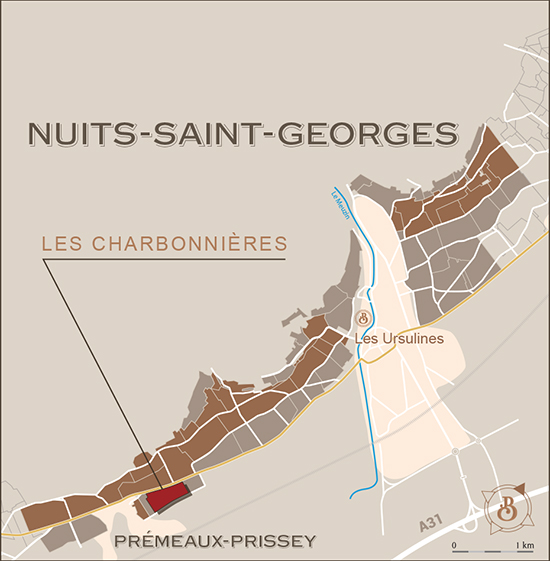Nuits-Saint-Georges
Les Charbonnières 2017
Nuits-Saint-Georges is one of those magical names that visitors recite like a rosary. Known the whole world over, Nuits-Saint-Georges has the original profile of a genuine wine village, but on the scale of a small town.
Origin
Halfway between Dijon and Beaune, and with an easterly exposure, the vineyards of Nuits-Saint-Georges spread over 6 kilometres, with 160ha of Village-appelation vines. The range of soils, exposure and locations here creates a great diversity of terroirs. The area is bisected by the valley of the Meuzin river, and the village itself.
Les Charbonnières are located at the southern end of the village, where the altitude is a little lower than in the north. The soil consists mainly of marl, combined with sand and pebbles from the top of the slope. Grape maturity is always excellent here.
Viticulture
Grape variety: pinot noir
Soils: marls associated with sand and pebbles from the top of the hill.
Orientation: South-East
Surface area under vine: 1.2267 ha
Pruning: Guyot system
Yield: 22 hL/ha
Average age of the vines: 55 years old.
Vinification
Harvest date: 11 September 2017.
The grapes were handpicked. They were sorted a first time in the vineyard and again on the sorting table when they arrived at the winery.
At the winery: the grapes were 50% destemmed, 50% left whole and were gravity-fed into tanks. Maceration lasted a total of 18 days including 5 days of cold maceration (12°C). Fermentation used indigenous yeasts only (no additives such as enzymes or tannins were used). 2 punchings of the cap. Vinification without sulfur.
Ageing
Maturation: aged on the lees for 16 months with no racking using a proportion of 35% new French oak barrels.
Barrels: French oak barrels that had been toasted at low temperatures for a long time to impart a very delicate touch of oak to the wine.
Bottling
Bottling: The wine was not fined but was very gently filtered before being bottled using gravity in March 2019.
Number of bottles: 3,540.
Vintage
2017 – Finesse
The growing cycle was thrown off-kilter by a very cold winter, late spring frost, then optimal conditions for rapid flowering, sporadic hail, and summer drought. Harvesting began in early September in the sun, and after several lean years, the vines finally produced abundant grapes, although with significant differences in maturity between whites and reds and from one region to another, which called for strict sorting.
Ageing potential: from 7 to 10 years.
Tasting notes
The color is brilliant ruby red. The complex nose exudes red fruit aromas embellished with mineral notes with some violet aromas. On the palate, this wine is silky with velvety tannins on the attack. The finish is more structured with some toasted notes.



